Analyzing the Impact of Renewable Energy on Australia's Economy
VerifiedAdded on 2023/06/14
|12
|1711
|477
Report
AI Summary
This report examines the current state of renewable energy in Australia and its economic implications. It highlights the sector's contribution to electricity generation, employment, and pollution reduction. The analysis uses economic concepts such as job creation, national income impact, externalities, and economies of scale to explain the sector's influence. The report finds that increased renewable energy production can lead to positive externalities and consumer surplus, but also requires significant initial investment. It recommends policies to encourage renewable energy consumption, reduce greenhouse gas emissions, and address the challenges of high housing costs. Ultimately, the report concludes that renewable energy plays a crucial role in Australia's economic and environmental sustainability, and continued development in this sector is essential.

Running head: ECONOMICS ASSIGNMENT
Economics Assignment
Name of the university
Name of the student
Author Note
Economics Assignment
Name of the university
Name of the student
Author Note
Paraphrase This Document
Need a fresh take? Get an instant paraphrase of this document with our AI Paraphraser
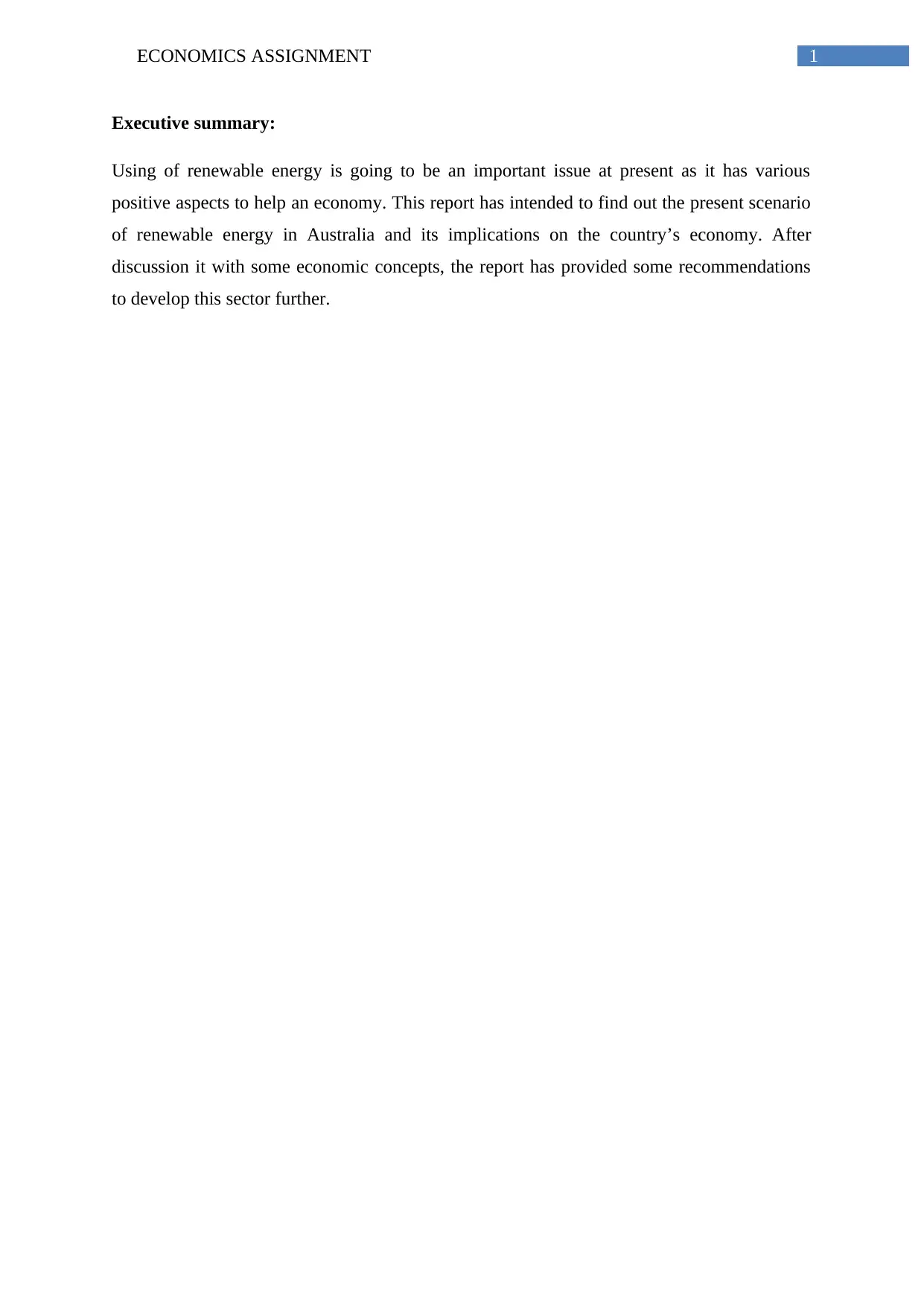
1ECONOMICS ASSIGNMENT
Executive summary:
Using of renewable energy is going to be an important issue at present as it has various
positive aspects to help an economy. This report has intended to find out the present scenario
of renewable energy in Australia and its implications on the country’s economy. After
discussion it with some economic concepts, the report has provided some recommendations
to develop this sector further.
Executive summary:
Using of renewable energy is going to be an important issue at present as it has various
positive aspects to help an economy. This report has intended to find out the present scenario
of renewable energy in Australia and its implications on the country’s economy. After
discussion it with some economic concepts, the report has provided some recommendations
to develop this sector further.
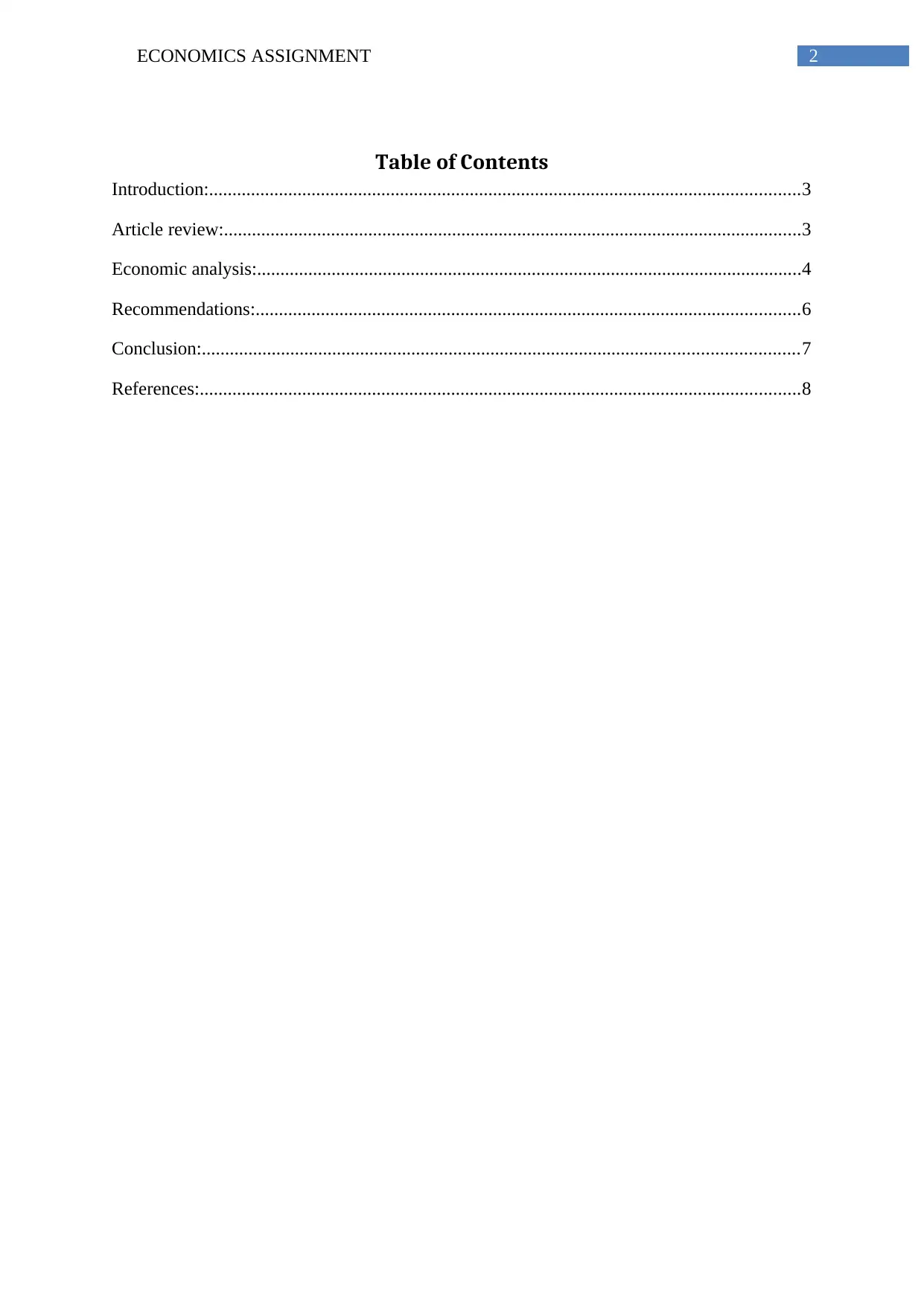
2ECONOMICS ASSIGNMENT
Table of Contents
Introduction:...............................................................................................................................3
Article review:............................................................................................................................3
Economic analysis:.....................................................................................................................4
Recommendations:.....................................................................................................................6
Conclusion:................................................................................................................................7
References:.................................................................................................................................8
Table of Contents
Introduction:...............................................................................................................................3
Article review:............................................................................................................................3
Economic analysis:.....................................................................................................................4
Recommendations:.....................................................................................................................6
Conclusion:................................................................................................................................7
References:.................................................................................................................................8
⊘ This is a preview!⊘
Do you want full access?
Subscribe today to unlock all pages.

Trusted by 1+ million students worldwide
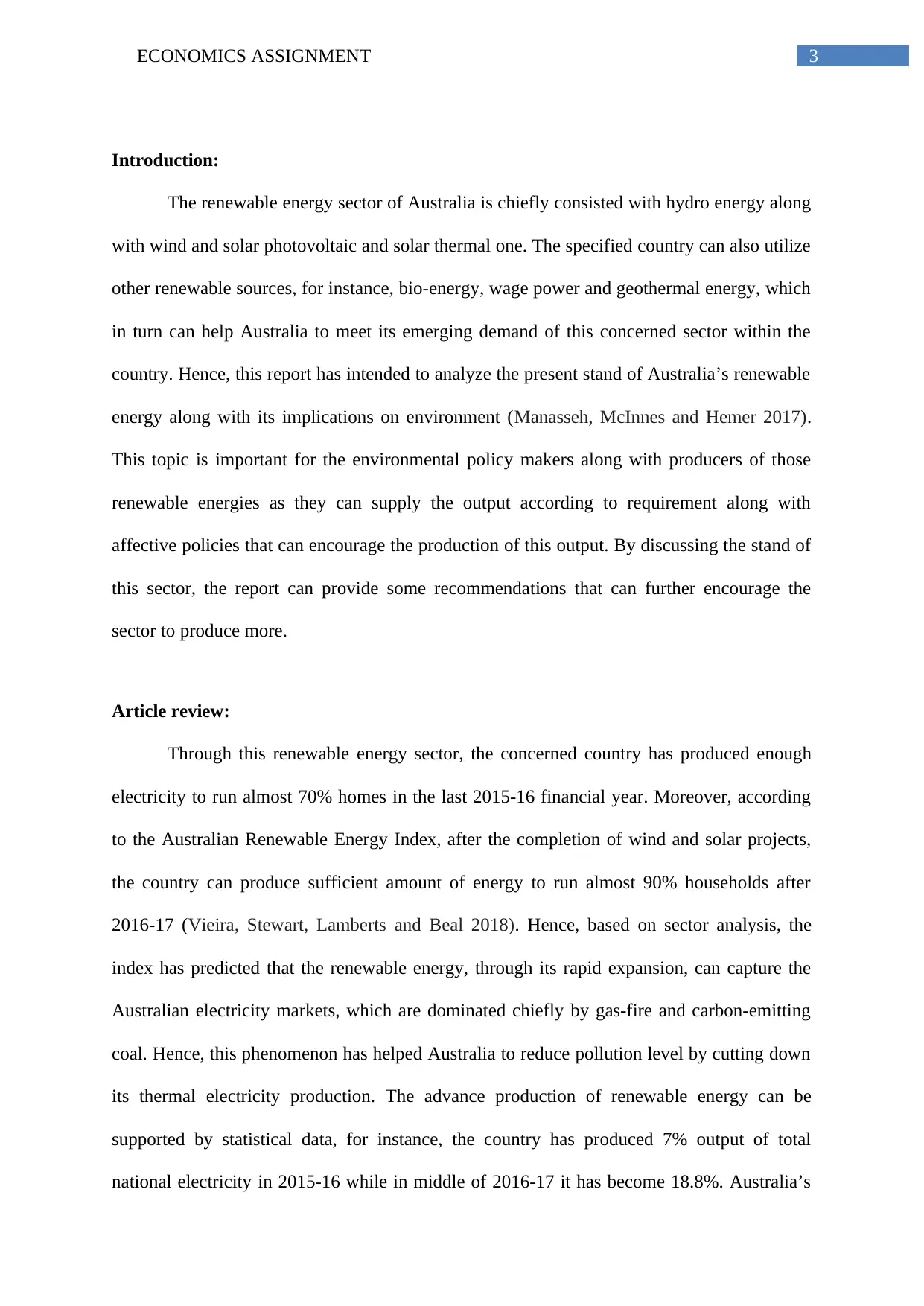
3ECONOMICS ASSIGNMENT
Introduction:
The renewable energy sector of Australia is chiefly consisted with hydro energy along
with wind and solar photovoltaic and solar thermal one. The specified country can also utilize
other renewable sources, for instance, bio-energy, wage power and geothermal energy, which
in turn can help Australia to meet its emerging demand of this concerned sector within the
country. Hence, this report has intended to analyze the present stand of Australia’s renewable
energy along with its implications on environment (Manasseh, McInnes and Hemer 2017).
This topic is important for the environmental policy makers along with producers of those
renewable energies as they can supply the output according to requirement along with
affective policies that can encourage the production of this output. By discussing the stand of
this sector, the report can provide some recommendations that can further encourage the
sector to produce more.
Article review:
Through this renewable energy sector, the concerned country has produced enough
electricity to run almost 70% homes in the last 2015-16 financial year. Moreover, according
to the Australian Renewable Energy Index, after the completion of wind and solar projects,
the country can produce sufficient amount of energy to run almost 90% households after
2016-17 (Vieira, Stewart, Lamberts and Beal 2018). Hence, based on sector analysis, the
index has predicted that the renewable energy, through its rapid expansion, can capture the
Australian electricity markets, which are dominated chiefly by gas-fire and carbon-emitting
coal. Hence, this phenomenon has helped Australia to reduce pollution level by cutting down
its thermal electricity production. The advance production of renewable energy can be
supported by statistical data, for instance, the country has produced 7% output of total
national electricity in 2015-16 while in middle of 2016-17 it has become 18.8%. Australia’s
Introduction:
The renewable energy sector of Australia is chiefly consisted with hydro energy along
with wind and solar photovoltaic and solar thermal one. The specified country can also utilize
other renewable sources, for instance, bio-energy, wage power and geothermal energy, which
in turn can help Australia to meet its emerging demand of this concerned sector within the
country. Hence, this report has intended to analyze the present stand of Australia’s renewable
energy along with its implications on environment (Manasseh, McInnes and Hemer 2017).
This topic is important for the environmental policy makers along with producers of those
renewable energies as they can supply the output according to requirement along with
affective policies that can encourage the production of this output. By discussing the stand of
this sector, the report can provide some recommendations that can further encourage the
sector to produce more.
Article review:
Through this renewable energy sector, the concerned country has produced enough
electricity to run almost 70% homes in the last 2015-16 financial year. Moreover, according
to the Australian Renewable Energy Index, after the completion of wind and solar projects,
the country can produce sufficient amount of energy to run almost 90% households after
2016-17 (Vieira, Stewart, Lamberts and Beal 2018). Hence, based on sector analysis, the
index has predicted that the renewable energy, through its rapid expansion, can capture the
Australian electricity markets, which are dominated chiefly by gas-fire and carbon-emitting
coal. Hence, this phenomenon has helped Australia to reduce pollution level by cutting down
its thermal electricity production. The advance production of renewable energy can be
supported by statistical data, for instance, the country has produced 7% output of total
national electricity in 2015-16 while in middle of 2016-17 it has become 18.8%. Australia’s
Paraphrase This Document
Need a fresh take? Get an instant paraphrase of this document with our AI Paraphraser
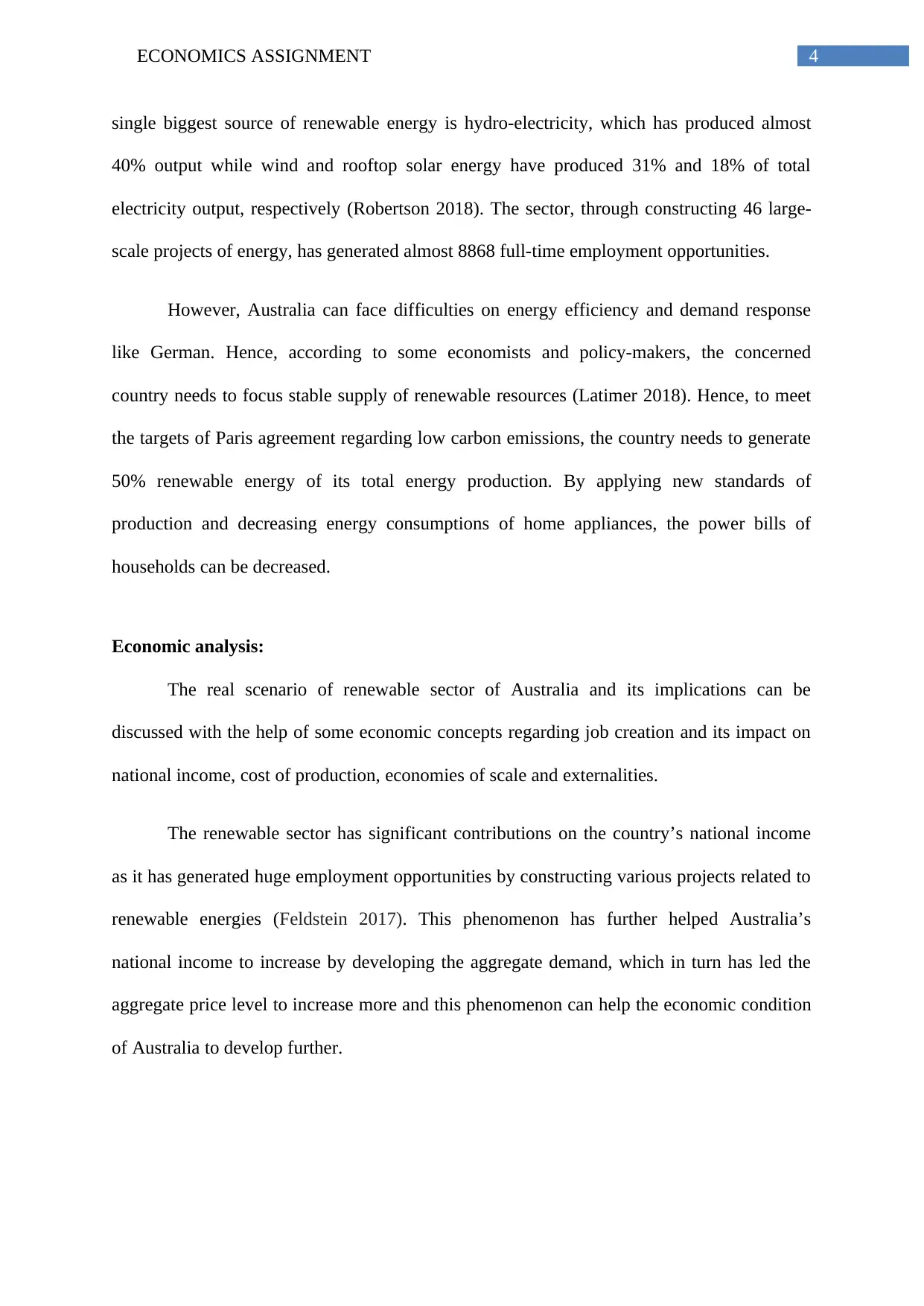
4ECONOMICS ASSIGNMENT
single biggest source of renewable energy is hydro-electricity, which has produced almost
40% output while wind and rooftop solar energy have produced 31% and 18% of total
electricity output, respectively (Robertson 2018). The sector, through constructing 46 large-
scale projects of energy, has generated almost 8868 full-time employment opportunities.
However, Australia can face difficulties on energy efficiency and demand response
like German. Hence, according to some economists and policy-makers, the concerned
country needs to focus stable supply of renewable resources (Latimer 2018). Hence, to meet
the targets of Paris agreement regarding low carbon emissions, the country needs to generate
50% renewable energy of its total energy production. By applying new standards of
production and decreasing energy consumptions of home appliances, the power bills of
households can be decreased.
Economic analysis:
The real scenario of renewable sector of Australia and its implications can be
discussed with the help of some economic concepts regarding job creation and its impact on
national income, cost of production, economies of scale and externalities.
The renewable sector has significant contributions on the country’s national income
as it has generated huge employment opportunities by constructing various projects related to
renewable energies (Feldstein 2017). This phenomenon has further helped Australia’s
national income to increase by developing the aggregate demand, which in turn has led the
aggregate price level to increase more and this phenomenon can help the economic condition
of Australia to develop further.
single biggest source of renewable energy is hydro-electricity, which has produced almost
40% output while wind and rooftop solar energy have produced 31% and 18% of total
electricity output, respectively (Robertson 2018). The sector, through constructing 46 large-
scale projects of energy, has generated almost 8868 full-time employment opportunities.
However, Australia can face difficulties on energy efficiency and demand response
like German. Hence, according to some economists and policy-makers, the concerned
country needs to focus stable supply of renewable resources (Latimer 2018). Hence, to meet
the targets of Paris agreement regarding low carbon emissions, the country needs to generate
50% renewable energy of its total energy production. By applying new standards of
production and decreasing energy consumptions of home appliances, the power bills of
households can be decreased.
Economic analysis:
The real scenario of renewable sector of Australia and its implications can be
discussed with the help of some economic concepts regarding job creation and its impact on
national income, cost of production, economies of scale and externalities.
The renewable sector has significant contributions on the country’s national income
as it has generated huge employment opportunities by constructing various projects related to
renewable energies (Feldstein 2017). This phenomenon has further helped Australia’s
national income to increase by developing the aggregate demand, which in turn has led the
aggregate price level to increase more and this phenomenon can help the economic condition
of Australia to develop further.
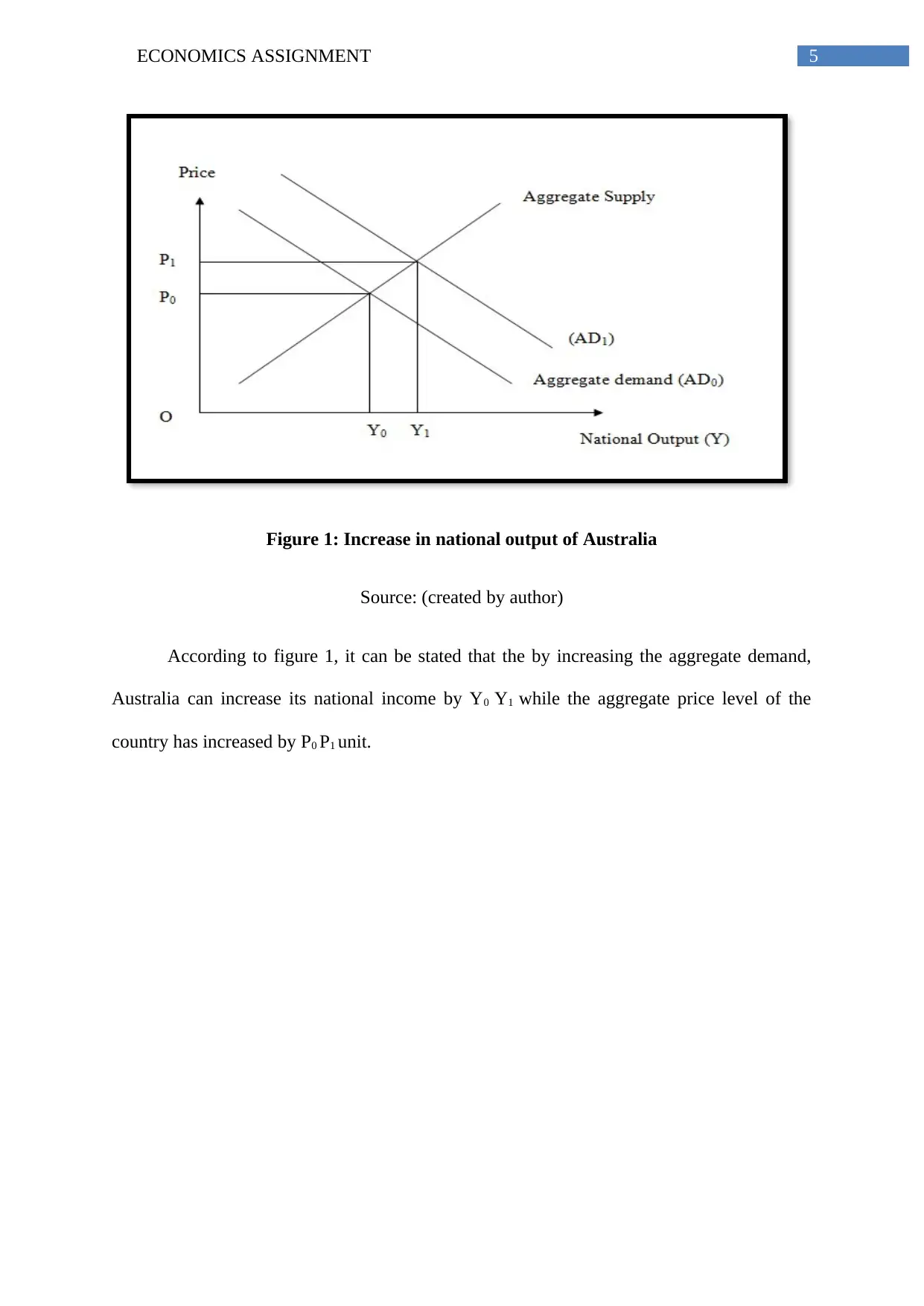
5ECONOMICS ASSIGNMENT
Figure 1: Increase in national output of Australia
Source: (created by author)
According to figure 1, it can be stated that the by increasing the aggregate demand,
Australia can increase its national income by Y0 Y1 while the aggregate price level of the
country has increased by P0 P1 unit.
Figure 1: Increase in national output of Australia
Source: (created by author)
According to figure 1, it can be stated that the by increasing the aggregate demand,
Australia can increase its national income by Y0 Y1 while the aggregate price level of the
country has increased by P0 P1 unit.
⊘ This is a preview!⊘
Do you want full access?
Subscribe today to unlock all pages.

Trusted by 1+ million students worldwide
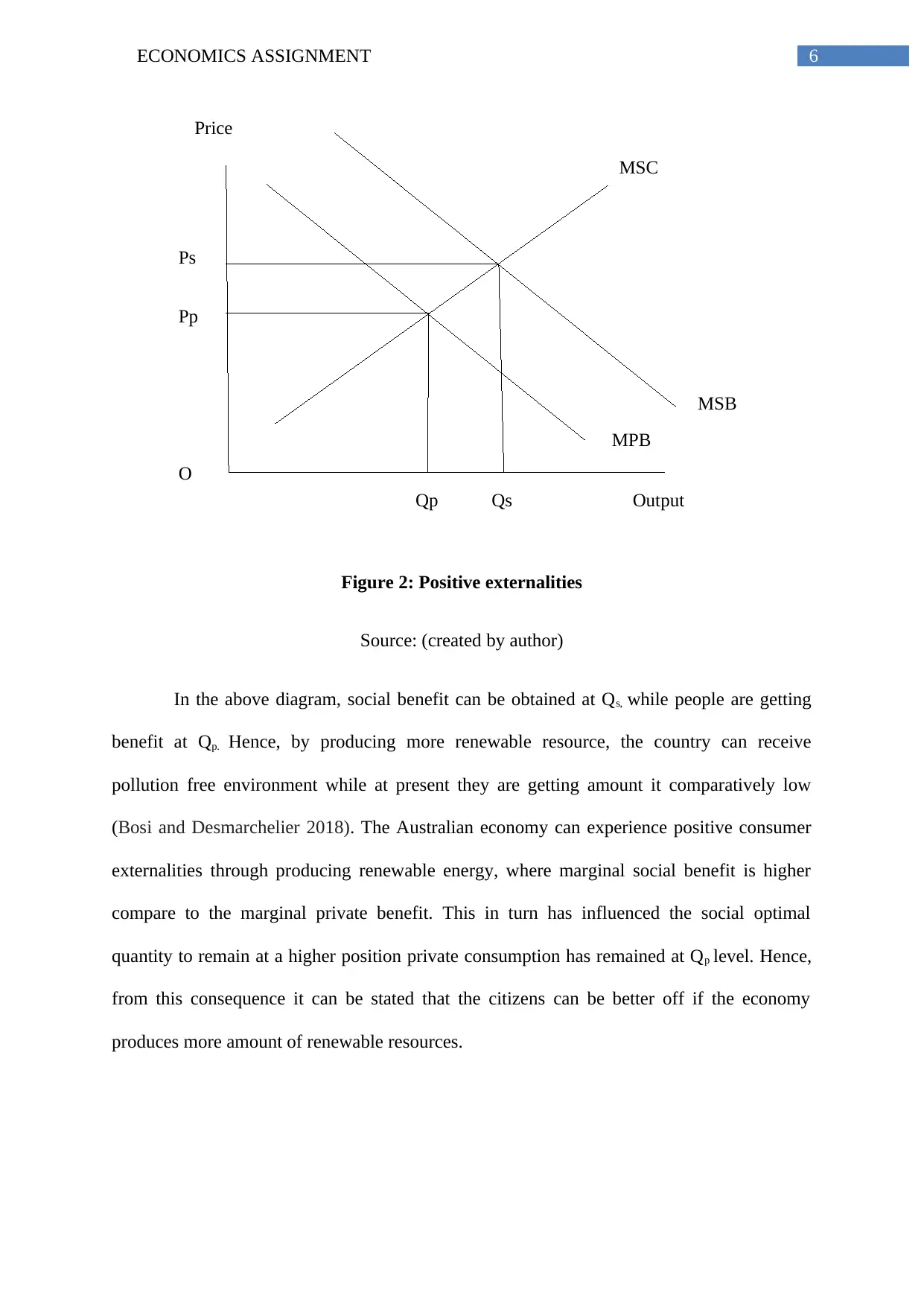
6ECONOMICS ASSIGNMENT
Price
Output
O
MPB
MSB
MSC
Ps
Pp
Qp Qs
Figure 2: Positive externalities
Source: (created by author)
In the above diagram, social benefit can be obtained at Qs, while people are getting
benefit at Qp. Hence, by producing more renewable resource, the country can receive
pollution free environment while at present they are getting amount it comparatively low
(Bosi and Desmarchelier 2018). The Australian economy can experience positive consumer
externalities through producing renewable energy, where marginal social benefit is higher
compare to the marginal private benefit. This in turn has influenced the social optimal
quantity to remain at a higher position private consumption has remained at Qp level. Hence,
from this consequence it can be stated that the citizens can be better off if the economy
produces more amount of renewable resources.
Price
Output
O
MPB
MSB
MSC
Ps
Pp
Qp Qs
Figure 2: Positive externalities
Source: (created by author)
In the above diagram, social benefit can be obtained at Qs, while people are getting
benefit at Qp. Hence, by producing more renewable resource, the country can receive
pollution free environment while at present they are getting amount it comparatively low
(Bosi and Desmarchelier 2018). The Australian economy can experience positive consumer
externalities through producing renewable energy, where marginal social benefit is higher
compare to the marginal private benefit. This in turn has influenced the social optimal
quantity to remain at a higher position private consumption has remained at Qp level. Hence,
from this consequence it can be stated that the citizens can be better off if the economy
produces more amount of renewable resources.
Paraphrase This Document
Need a fresh take? Get an instant paraphrase of this document with our AI Paraphraser

7ECONOMICS ASSIGNMENT
Figure 3: Economics of scale
Source: (created by author)
On the other side, to produce renewable energy, the economy needs to bear huge
costs, for instance, construction of new project plans (Badunenko and Kumbhakar 2017).
However, increasing amount of energy production has led the production cost to decrease.
This implication has helped the consumers of renewable energy to pay fewer bills, which in
turn has generated consumer surplus in this market.
Recommendations:
The large number of population with huge cost price for houses has generated burdens
on Australian policymakers. Hence, by generating more renewable energies with lower price
can reduce the cost burden of Australian citizens. This in turn can generate consumer surplus.
Moreover, the government can reduce the taxes on those energies to encourage people for
using this by large amount. Hence, through effective fiscal policies, the government can
encourage people to consume more renewable energy.
Figure 3: Economics of scale
Source: (created by author)
On the other side, to produce renewable energy, the economy needs to bear huge
costs, for instance, construction of new project plans (Badunenko and Kumbhakar 2017).
However, increasing amount of energy production has led the production cost to decrease.
This implication has helped the consumers of renewable energy to pay fewer bills, which in
turn has generated consumer surplus in this market.
Recommendations:
The large number of population with huge cost price for houses has generated burdens
on Australian policymakers. Hence, by generating more renewable energies with lower price
can reduce the cost burden of Australian citizens. This in turn can generate consumer surplus.
Moreover, the government can reduce the taxes on those energies to encourage people for
using this by large amount. Hence, through effective fiscal policies, the government can
encourage people to consume more renewable energy.
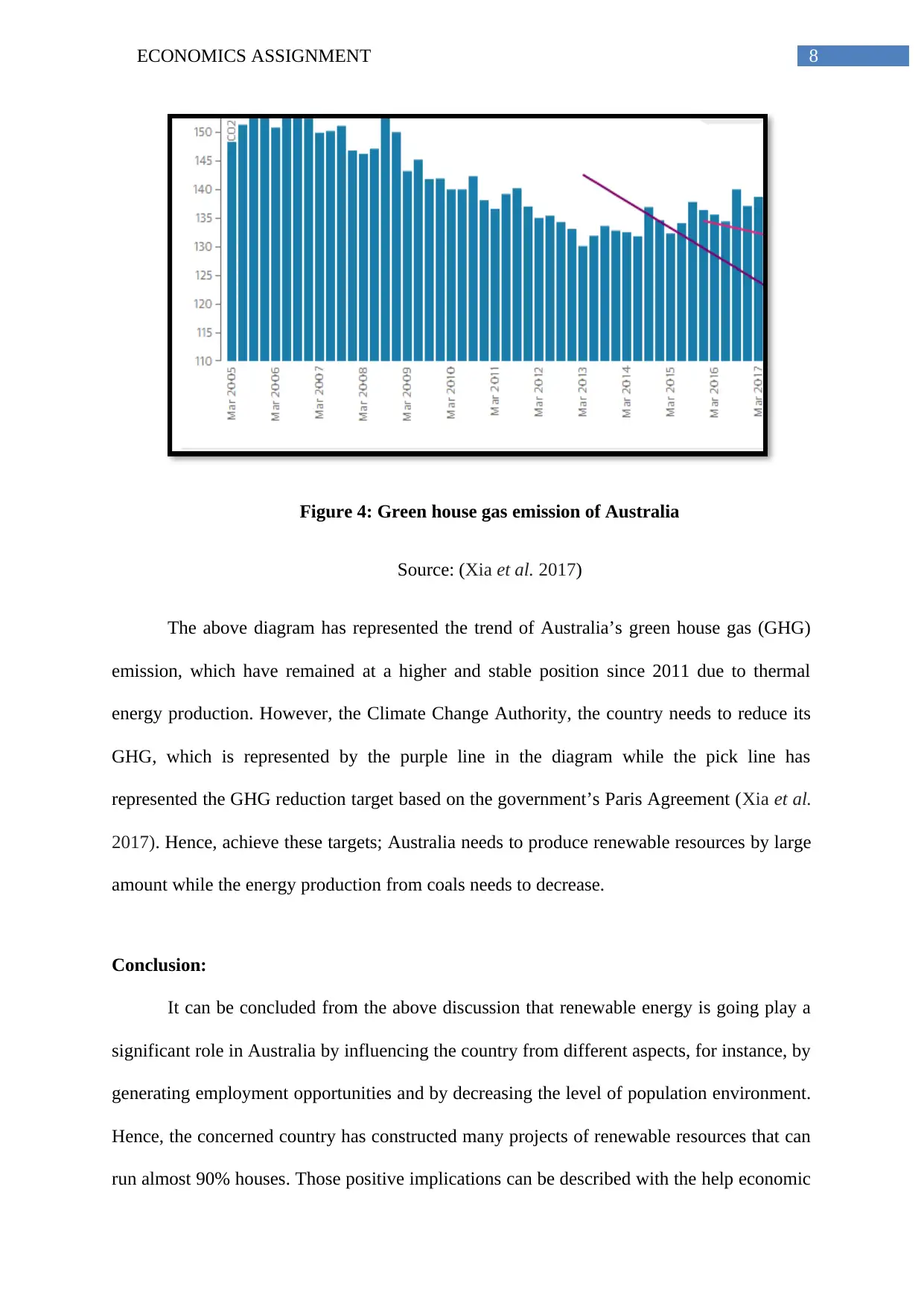
8ECONOMICS ASSIGNMENT
Figure 4: Green house gas emission of Australia
Source: (Xia et al. 2017)
The above diagram has represented the trend of Australia’s green house gas (GHG)
emission, which have remained at a higher and stable position since 2011 due to thermal
energy production. However, the Climate Change Authority, the country needs to reduce its
GHG, which is represented by the purple line in the diagram while the pick line has
represented the GHG reduction target based on the government’s Paris Agreement (Xia et al.
2017). Hence, achieve these targets; Australia needs to produce renewable resources by large
amount while the energy production from coals needs to decrease.
Conclusion:
It can be concluded from the above discussion that renewable energy is going play a
significant role in Australia by influencing the country from different aspects, for instance, by
generating employment opportunities and by decreasing the level of population environment.
Hence, the concerned country has constructed many projects of renewable resources that can
run almost 90% houses. Those positive implications can be described with the help economic
Figure 4: Green house gas emission of Australia
Source: (Xia et al. 2017)
The above diagram has represented the trend of Australia’s green house gas (GHG)
emission, which have remained at a higher and stable position since 2011 due to thermal
energy production. However, the Climate Change Authority, the country needs to reduce its
GHG, which is represented by the purple line in the diagram while the pick line has
represented the GHG reduction target based on the government’s Paris Agreement (Xia et al.
2017). Hence, achieve these targets; Australia needs to produce renewable resources by large
amount while the energy production from coals needs to decrease.
Conclusion:
It can be concluded from the above discussion that renewable energy is going play a
significant role in Australia by influencing the country from different aspects, for instance, by
generating employment opportunities and by decreasing the level of population environment.
Hence, the concerned country has constructed many projects of renewable resources that can
run almost 90% houses. Those positive implications can be described with the help economic
⊘ This is a preview!⊘
Do you want full access?
Subscribe today to unlock all pages.

Trusted by 1+ million students worldwide
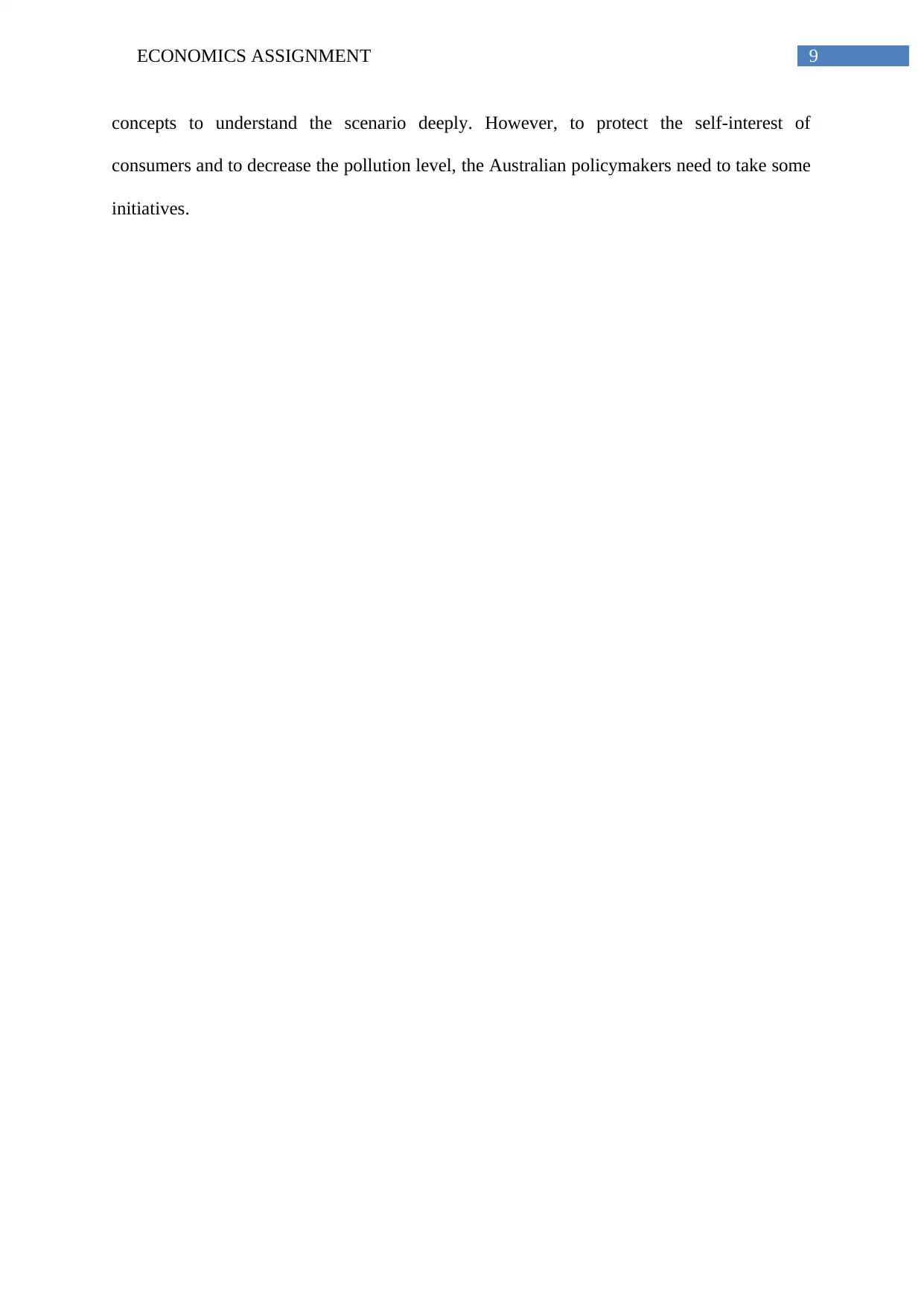
9ECONOMICS ASSIGNMENT
concepts to understand the scenario deeply. However, to protect the self-interest of
consumers and to decrease the pollution level, the Australian policymakers need to take some
initiatives.
concepts to understand the scenario deeply. However, to protect the self-interest of
consumers and to decrease the pollution level, the Australian policymakers need to take some
initiatives.
Paraphrase This Document
Need a fresh take? Get an instant paraphrase of this document with our AI Paraphraser
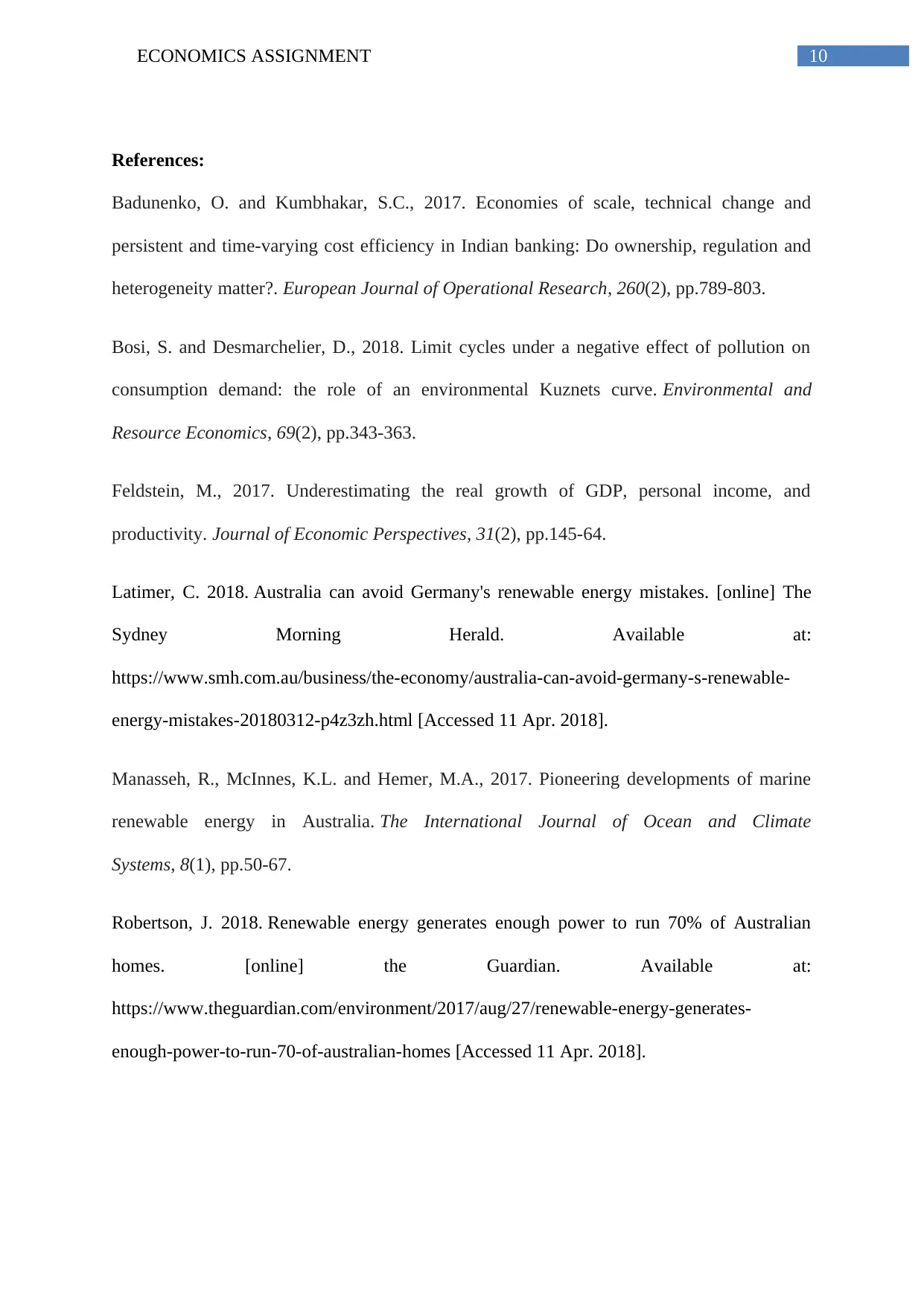
10ECONOMICS ASSIGNMENT
References:
Badunenko, O. and Kumbhakar, S.C., 2017. Economies of scale, technical change and
persistent and time-varying cost efficiency in Indian banking: Do ownership, regulation and
heterogeneity matter?. European Journal of Operational Research, 260(2), pp.789-803.
Bosi, S. and Desmarchelier, D., 2018. Limit cycles under a negative effect of pollution on
consumption demand: the role of an environmental Kuznets curve. Environmental and
Resource Economics, 69(2), pp.343-363.
Feldstein, M., 2017. Underestimating the real growth of GDP, personal income, and
productivity. Journal of Economic Perspectives, 31(2), pp.145-64.
Latimer, C. 2018. Australia can avoid Germany's renewable energy mistakes. [online] The
Sydney Morning Herald. Available at:
https://www.smh.com.au/business/the-economy/australia-can-avoid-germany-s-renewable-
energy-mistakes-20180312-p4z3zh.html [Accessed 11 Apr. 2018].
Manasseh, R., McInnes, K.L. and Hemer, M.A., 2017. Pioneering developments of marine
renewable energy in Australia. The International Journal of Ocean and Climate
Systems, 8(1), pp.50-67.
Robertson, J. 2018. Renewable energy generates enough power to run 70% of Australian
homes. [online] the Guardian. Available at:
https://www.theguardian.com/environment/2017/aug/27/renewable-energy-generates-
enough-power-to-run-70-of-australian-homes [Accessed 11 Apr. 2018].
References:
Badunenko, O. and Kumbhakar, S.C., 2017. Economies of scale, technical change and
persistent and time-varying cost efficiency in Indian banking: Do ownership, regulation and
heterogeneity matter?. European Journal of Operational Research, 260(2), pp.789-803.
Bosi, S. and Desmarchelier, D., 2018. Limit cycles under a negative effect of pollution on
consumption demand: the role of an environmental Kuznets curve. Environmental and
Resource Economics, 69(2), pp.343-363.
Feldstein, M., 2017. Underestimating the real growth of GDP, personal income, and
productivity. Journal of Economic Perspectives, 31(2), pp.145-64.
Latimer, C. 2018. Australia can avoid Germany's renewable energy mistakes. [online] The
Sydney Morning Herald. Available at:
https://www.smh.com.au/business/the-economy/australia-can-avoid-germany-s-renewable-
energy-mistakes-20180312-p4z3zh.html [Accessed 11 Apr. 2018].
Manasseh, R., McInnes, K.L. and Hemer, M.A., 2017. Pioneering developments of marine
renewable energy in Australia. The International Journal of Ocean and Climate
Systems, 8(1), pp.50-67.
Robertson, J. 2018. Renewable energy generates enough power to run 70% of Australian
homes. [online] the Guardian. Available at:
https://www.theguardian.com/environment/2017/aug/27/renewable-energy-generates-
enough-power-to-run-70-of-australian-homes [Accessed 11 Apr. 2018].
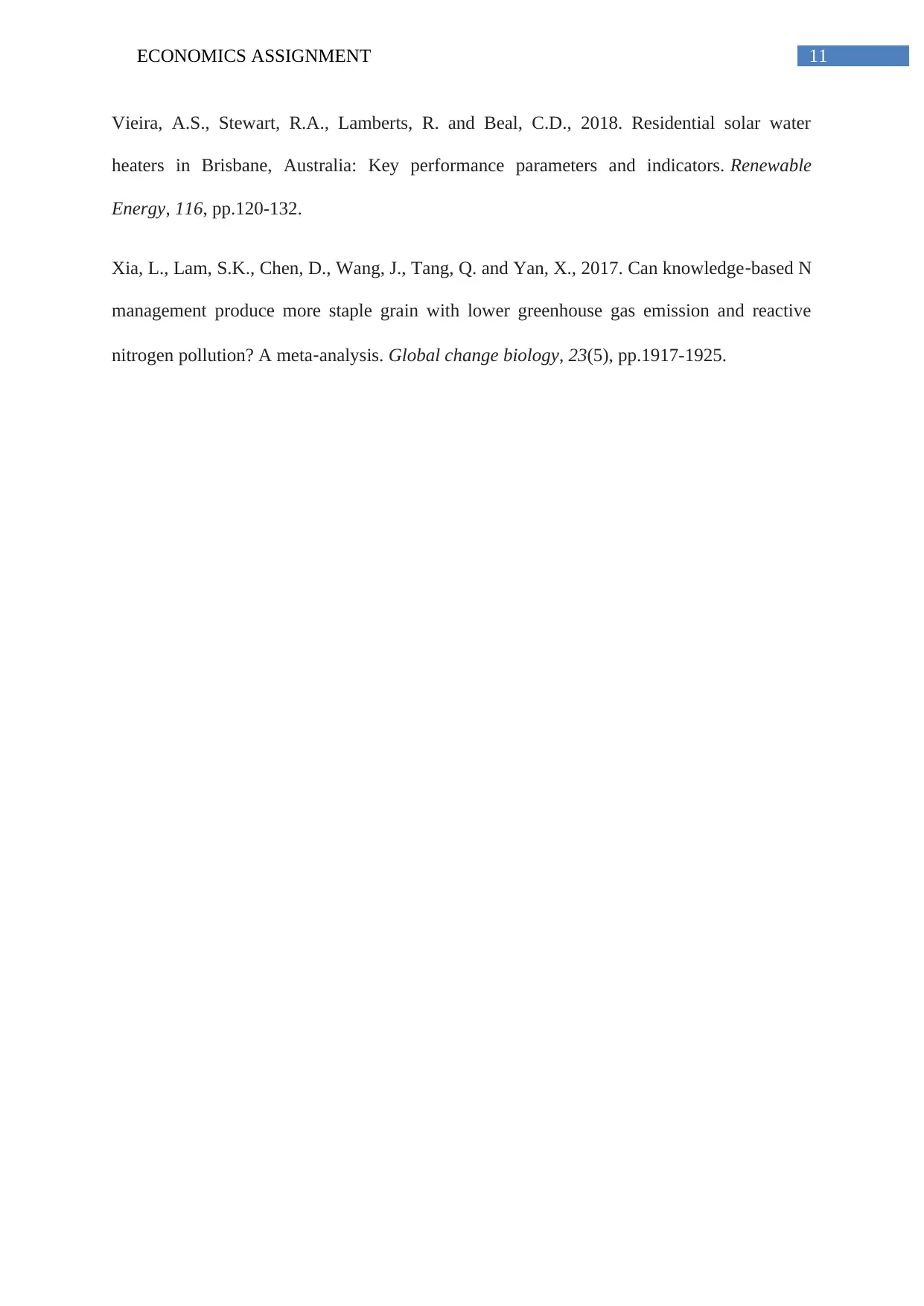
11ECONOMICS ASSIGNMENT
Vieira, A.S., Stewart, R.A., Lamberts, R. and Beal, C.D., 2018. Residential solar water
heaters in Brisbane, Australia: Key performance parameters and indicators. Renewable
Energy, 116, pp.120-132.
Xia, L., Lam, S.K., Chen, D., Wang, J., Tang, Q. and Yan, X., 2017. Can knowledge‐based N
management produce more staple grain with lower greenhouse gas emission and reactive
nitrogen pollution? A meta‐analysis. Global change biology, 23(5), pp.1917-1925.
Vieira, A.S., Stewart, R.A., Lamberts, R. and Beal, C.D., 2018. Residential solar water
heaters in Brisbane, Australia: Key performance parameters and indicators. Renewable
Energy, 116, pp.120-132.
Xia, L., Lam, S.K., Chen, D., Wang, J., Tang, Q. and Yan, X., 2017. Can knowledge‐based N
management produce more staple grain with lower greenhouse gas emission and reactive
nitrogen pollution? A meta‐analysis. Global change biology, 23(5), pp.1917-1925.
⊘ This is a preview!⊘
Do you want full access?
Subscribe today to unlock all pages.

Trusted by 1+ million students worldwide
1 out of 12
Related Documents
Your All-in-One AI-Powered Toolkit for Academic Success.
+13062052269
info@desklib.com
Available 24*7 on WhatsApp / Email
![[object Object]](/_next/static/media/star-bottom.7253800d.svg)
Unlock your academic potential
Copyright © 2020–2025 A2Z Services. All Rights Reserved. Developed and managed by ZUCOL.





